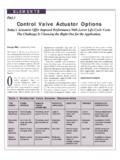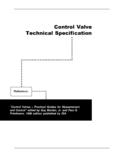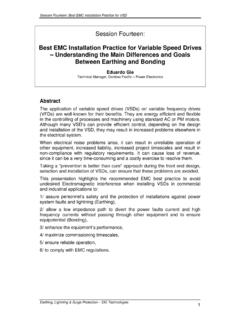Transcription of Electrical Equipment in Hazardous Areas: Field Inspections
1 Hazardous Areas Conference 2007 IDC Technologies 1 Electrical Equipment in Hazardous Areas: Field Inspections Bill Rankin Electrical Engineer / Senior Electrical Inspector Abstract Electrical Equipment and installations that fall within explosive gas atmospheres are required to comply with the applicable regulations of the Australian State or Territory. The general requirements for the selection, installation and maintenance of Electrical Equipment for explosive gas atmospheres are detailed in AS/NZS :2005. The requirements of this standard are mandatory and are called up in the applicable Acts or Regulations of each State or Territory. An important requirement of AS :2005 Section 4 is to ensure that installations are maintained in a satisfactory condition and shall be subject to Electrical Equipment in Hazardous Areas (EEHA) Inspections .
2 1. Background: Why perform Electrical Equipment in Hazardous areas Inspections ? Perhaps you have heard the expression if it s not broken don t fix it . The same can be said for Electrical Equipment in Hazardous Areas (EEHA) Inspections and there is often a great deal of resistance from engineering and production managers to perform Electrical Inspections which may involve the isolation certain Equipment or partial plant shutdown. It is a fact that if the Electrical inspector lacks the necessary experience, the EEHA inspection could indeed do more harm than good, resulting in damage to Electrical apparatus , tripping of Electrical circuits or extended isolations. For this reason only competent personnel should be employed for the purpose of performing EEHA Inspections . Using a competent Electrical inspector will provide the owners or users of the plant with a condition assessment of the Electrical installation in Hazardous areas to ensure that it is maintained in a satisfactory condition.
3 It is also a requirement of AS/NZS :2005 Section 4 that EEHA Inspections be performed on a regular periodic basis or under continuous supervision by competent personnel. The requirements of this standard are mandatory in Western Australia, where reference is made to Australian Standard 2381 in the Electricity (Licensing) Regulations 1991 (WA). Other Australian States and Territories have similar legislation referring to AS 2381. Before embarking upon an inspection of Electrical Equipment within a Hazardous area , the hazards associated with the flammable gas or vapour must be understood and the extent of the Hazardous zone must be clearly defined. It is a fruitless exercise to begin an EEHA inspection without a clear definition of the Hazardous zones. Internationally, the classification of Hazardous areas has traditionally been carried out by individuals Hazardous Areas Conference 2007 IDC Technologies 2 representing the legal owners/users of the plant.
4 Often these persons lack expertise in Hazardous areas classifications as well as the specific knowledge of the properties of the flammable materials. As a result, inconsistencies may exist in the limits of the Hazardous zones. However, in more recent times Hazardous areas classification has tended to be carried out by professional multidisciplinary engineering consultancies specialising in Hazardous locations classifications. The Electrical inspector performing the EEHA inspection should verify that the existing area classification remains correct and that there have been no changes to plant or processes that may affect the Hazardous zones. 2. The classification of Hazardous locations and the selection of apparatus for such locations Understanding the zone classification Hazardous locations are classified into zones so as to facilitate the selection of the correct Electrical apparatus and to ensure that the Electrical design and installation meets the specified requirements to be used in different areas.
5 The zone classification is based on the likelihood and the duration of an explosive atmosphere. The zone classification for gases is divided into three zones, namely Zone 0, Zone 1 and Zone 2 and for dusts Zone 20, Zone 21 and Zone 22. Definition of Hazardous area zones (AS/NZS ): Zone 0 Place in which an explosive atmosphere consisting of a mixture with air of flammable substance in the form of gas, vapour or mist is present continuously for long periods or frequently It is the author s experience that a Zone 0 condition is rarely encountered and is limited mainly to confined spaces (such as the vapour space of closed process vessels, closed storage tanks and closed containers), although it can occur in larger rooms, such as chemical plants. From the Institute of Petroleum (IP 15) an exposure exceeding 1000 hours per year is often used.
6 Zone 1 Place in which an explosive atmosphere consisting of a mixture with air of flammable substances in the form of gas, vapour or mist is likely to occur in normal operation occasionally A Zone 1 classification usually includes locations where volatile flammable liquids or liquefied flammable gasses are transferred; gas generator rooms; inadequately ventilated pump rooms for flammable gases or for volatile flammable liquids; and most other locations where Hazardous concentrations of flammable vapours or gases can occur in the course of normal operations. IP 15 stipulates between 10 hours and 1000. Hazardous Areas Conference 2007 IDC Technologies 3 Zone 2 Place in which an explosive atmosphere consisting of a mixture with air of flammable substances in the form of gas, vapour or mist is not likely to occur in normal operation but, if it does occur, will persist for a short period only Generally, for an area to be classified as a Zone 2 location the following conditions shall normally be regarded as the minimum requirements for the area : a) the area is so well ventilated that if an abnormal conditions arises, ignitable concentrations of the gas or vapour are rapidly dispersed; and b) complete segregation from Zone 1 locations is ensured.
7 In this case an expose to flammable vapours or gases of less than 10 hours per annum is prescribed in IP 15. Review: Has the appropriate apparatus for the zone classification been installed? The table below lists the suitable Electrical apparatus for Zone 0, Zone 1 and Zone 2 locations. From this table is can clearly be seen that Electrical explosion protected flameproof (Ex d) Equipment may not be installed in a Zone 0 location, although Equipment certified for use a Zone 0 location may be installed in a Zone 1 or Zone 2 area . When performing an EEHA inspection , the suitability of the method of protection for the given zone will need to be verified. Selection of Electrical Equipment for Zone 0, 1 and 2 Hazardous Areas Hazardous Areas Conference 2007 IDC Technologies 4 Description of Explosion Protection Technique Designated Symbol Comments Zone 0 Limited to the Following explosion protection techniques intrinsically safe Ex ia Encapsulated Ex ma Special Protection Ex s To Zone 0 requirements Zone 1 In addition to Zone 0 techniques the following methods are acceptable intrinsically safe Ex ib Encapsulated Ex mb or Ex m Special Protection Ex s To Zone 1 requirements Increased Safety Ex e Ventilation Ex v To Zone 1 requirements Powder or Sand Quartz Filling Ex q Flameproof
8 Ex d Oil Immersion Ex o Pressurised rooms and enclosures Ex p To Zone 1 requirements Zone 2 In addition to Zone 0 and Zone 1 techniques the following methods are acceptable Special Protection Ex s To Zone 2 requirements Ventilation Ex v To Zone 2 requirements Pressurised rooms and enclosures Ex p To Zone 2 requirements Non-sparking Ex n Review: Class of hazard Hazardous areas have traditionally been divided into two classes namely Class 1 and Class 2. Class 1 was for gases and vapours and Class 2 was for dusts. When performing Electrical Inspections , the class of the Equipment would be noted on the Explosion Protection Certificate and on the Ex plate and should be recorded for inspection purposes.
9 However, in 1999 Australia adopted the IEC system which does not refer to classes, and as such the class classification system is now obsolete in Australia. Review: Gas group When performing an Electrical inspection , it is important to recognise that the criterion for determining if Electrical apparatus is certified for use in a given location is not only based on the zone classification, but on the selection of the gas group and the temperature for the flammable atmosphere. Hazardous Areas Conference 2007 IDC Technologies 5 It is a common misconception that explosion protected apparatus suitable for a Zone 1 area such as Flameproof (Ex d) apparatus is automatically suitable for all Zone 1 locations. The gas group of the environment also needs to be considered.
10 Electrical Equipment for Hazardous gas areas is grouped as follows: a) Group I Electrical Equipment for mines susceptible to methane, and b) Group II Electrical Equipment for all places with an explosive gas atmosphere, other than mines susceptible to methane. Group II is then further divided into subgroups IIA, IIB or IIC. Note: if the Equipment is certified for gas group IIA is may not be used in a group IIB or IIC environment. Equipment identified as suitable for gas group IIB can also be used for gas group IIA. If the Equipment is certified for gas group IIC this encompasses use in gas group IIA, IIB, or IIC environments. For example Equipment certified for Zone 1 Ex d, IIB, T6 may not be used in explosive hydrogen environments as the gas group is IIC. Ignition characteristics gas groups Gas / Vapour Group Representative Test Gas I Methane IIA Propane IIB Ethylene IIC Hydrogen Review: Surface temperature applicable to the flammable material When determining the suitability of installed Electrical apparatus for a Hazardous area , the temperature class also needs to be reviewed.









